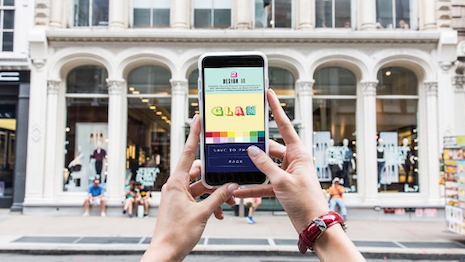Retailers are increasingly in tune with consumers’ expectations of personalized, seamless experiences across channels, with 56 percent of brands citing this as a top digital priority going forward, according to a new report by Boston Retail Partners.
As consumers and retailers alike have embraced mobile and online selling, the traditional retail silo model has been broken down to create a bridge between the physical and digital. Likewise, retailers now have a better grasp on bringing consumers an individualized and streamlined shopping experience, wherever, whenever and however they prefer to shop.
"This survey really demonstrates that retailers realize the importance of unified commerce and are moving the heart of the transaction to a centralized platform, this frees up their digital commerce applications to be more innovative and agile,” said Jeffrey Neville, vice president at Boston Retail Partners. “This allows retailers to utilize digital commerce to offer a personalized, ubiquitous and unified customer experience across channels in an efficient way.
“Online shopping has redefined the standards for the retail customer experience and capabilities,” he said. “The online or mobile shopper is now accustomed to receiving personalized offers and recommendations and having online retailers recognize them and their preferences whenever they shop.
"Today’s customers are no longer satisfied with a 'one size fits all' experience – they expect retailers to put time and effort into offering a personalized experience and if they don’t get it they will find a retailer who offers it.”
One-stop shop
BRP’s “2016 Digital Commerce Survey” shines a light on current digital commerce priorities and initiatives had by North American retailers.
These efforts will work to bring together the digital and physical selling spaces to provide consumers with options to shop anywhere, anytime and anyway they would like.
The concept of unified commerce will provide retailers with methods to provide consumers with personalized and seamless experiences through a single, centralized platform. By developing an order management system (OMS) as a singular transactional platform, retailers will be able to fulfill orders from a “single, shared cart.”

Image courtesy of Neiman Marcus
Once a single, shared cart platform is established, the OMS will become the retailer’s primary point for all transactions, inventory, pricing and order management, CRM, customer service and other aspects. BRP refers to this as the “glass pipeline of real-time visibility,” providing retailers with easy access to inventory, product information and, importantly, customer data.
By implementing a single, shared cart system, retailers will be more in sync with consumers' expectations of personal, ubiquitous and unified experiences when shopping online.
Of the North American retailers surveyed by BRP, 40 percent of respondents are focused on improving personalization tactics in the digital space. For digital marketing to be effective, retailers must push personalized, relevant, compelling and consistent messaging across all channels.

Image courtesy of Bloomingdale's
Fifty percent of respondents plan to place customer identifying technologies in-stores within the next two years. Being able to identify the consumer, either online, on a mobile app or in-store, is integral to personalization efforts.
BRP suggests identifying the consumer early in the transaction, regardless of the channel, to kick off a dialogue and establish the foundation of a relationship.
For in-store purchases, this can be accomplished by pinging their smartphone via a beacon, for example. By doing so, retailers can then personalize the experience as it happens. Geolocation tactics are likely to increase because of this reason, with 58 percent of retailers planning to use the technology within two years.
Although mobile purchasing is only a fraction of overall retail sales, the channel presents an opportunity for retailers because smartphones are most often used for research and information before an online or in-store purchase is complete. If viewed as a shopping tool, rather than a means of communication, retailers can trace a consumer's journey as she jumps from one channel to another to make a purchase.
With this in mind, 46 percent of respondents plan to improve their mobile shopping offers, claiming the on-the-go experience as a top digital priority.
An ubiquitous approach to digital selling is rooted in a single, shared cart system. Three-quarters of respondents intend on hosting a OMS of this kind within the next three years, and half of retailers will offer “start anywhere, finish anywhere” platforms in five years' time.

Image courtesy of Hugo Boss
For these strategies to be successfully applied, retailers must unify their internal infrastructure’s organization. By being unified and aligned across channels, retailers will be able to offer a seamless and consistent customer experience.
Fifty-six percent of retailers are focused on providing consumers with a consistent brand experience, and 73 percent plan to develop an OMS to centralize their unified commerce platforms to ensure this happens within three years.
To achieve their unified commerce goals, 38 percent of retailers who participated in BRP’s survey plan to create new roles and employee initiatives to accommodate these new tasks.
“The right organization is as important as implementing a single commerce platform to support the seamless brand experience across channels,” Mr. Neville said. “We have recently seen a shift in how retailers are arranging their organizations to better ensure a consistent brand experience across channels.
"Organizations are shifting their ecommerce areas from within the marketing organization to now align with the store organization, or the other way around," he said. "The common theme is that the leader of this combined organization is seen as an innovator who understands the unified commerce vision.
"The creation of a single 'retail' or 'commerce' organization overseen by a head of retail or chief customer officer, who is in charge of all interactions across all channels and has direct control over any changes or updates to the overall shopping experience. This alignment enables the overall organization to be more nimble and innovative as they work towards a seamless customer experience across all channels.”
Digital dilemmas
Across the board, the consumer majority feels that ecommerce lacks the personalized attention needed to be effective.
Sales associates are an integral part of in-store experiences, with 87 percent of consumers basing purchase decisions off the advice of a retail employee, according to a recent report by Salesfloor.
While in-store interactions are vital to a consumer’s purchasing journey, more than half of surveyed consumers say the same personalized synergy is lacking online. Salesfloor’s “2016 Omnichannel Retail Associate” study identifies the service gaps in online and bricks-and-mortar shopping experiences, a chasm that needs to be remedied for retailers to present consumers with seamless, omnichannel retailing (see story).
For luxury, specifically, the sector is currently facing a digital-or-die dilemma.
Seven percent of personal luxury goods sales are made via ecommerce today, but online retail will represent 12 percent of the luxury market by 2020, according to projections from the Boston Consulting Group.
About six out of every 10 luxury purchases currently are influenced by digital channels, as social media, a brand’s Web site and mobile feed into buying decisions, whether the transaction is completed online or in-store. While many luxury brands have been avoiding the shift toward digital that many of their mass counterparts have made, BCG warns that the business models of digital laggards will no longer suffice in today’s market (see story).
“Nordstrom is a great example of a luxury retailer that is successfully delivering cross-channel services,” Mr. Neville said. “They have built their environment around the customer and customer experience across channels.
"They realize that customers want to engage seamlessly across multiple touch points and have worked to align their organization to ensure they can support their customers’ shopping journey,” he said.
{"ct":"76Xl7AQ7iIE2OWuaJQeyV233eVXmATgkQBY0lq\/pnRjhzQ4fyOu3t8EsOfKRZLPJ3IUGGpwvBgjc1cc7pfFBcbRsH7mPZZa2Wvw86XWNSLipyMDyBEMgWyQpQudX6iieznsXYN3REaAwguxfgW4HfmJkFsFtCE2Ozc11RvEVVtr0gforJKnUgeYXaLnJvUBAdiFBJSJvkLgrIUdDeKL\/Gvet722DlzHpJaMzwUXeaYt5C+j7YUfurCmebzO0r8Am28hGrGKg\/RPbaSlQJ2p2XxbXLKo6LLcSEAOPGxaQ7BNdI260J8HumIfRMlV60K\/eNaPnb3sz\/L37CAgNYwqCrb1P27cpaJvTIcF+bf5SurFqgxIPD0auW9FEwvBnYvCV1uy+Sdyn6RLTd7CVf291+0pOgNYVSzuR9Y3qC1bOtuFi3Gm9x\/mOxjFCWDS6x83lMryiBgsV5dV9Gh3impveHYrKef9Od4eJxfREBm+yoWz97wRIuAnFEbbQ6lpgvvFQC+o24xzzSPySDBLMh52SnrabrYY0aNe3\/6khGEjCc0XGoNSPlji3OEhH3\/bM8J21SDGoFJJB\/g4rHhKvV2R1s\/ZGSjNETSEmmCdLLKWs+cpr61TRRlLo7ghxpc38YRsII+CYaLRJzBejYjC8pQb+rMg1\/sHn6t9b079xGT+tRxG21MYaHY5QceIOvVTJoGaEoTvtcp9tlhpqqR4bgAwpdiXBx3EC2B5TIKj16YNb9tMveaNaQBdZX4DQJuKxMHsqcvw5o057qDoNtcOOT0zrlXW1JiUV2geO\/CV8DN+iRCFpnM14psj3lVtyguF0fdgnNo\/slU49aTbC12GnWn5BTmAQFawIRfOgwxx5DQBg3TzIH4MMYHo1oJXJJQJBdk6lbGzneJMS7+w0YWPX0um2Xx8c3xVNUovJm7\/gog8g9ZuKgSxdWwV1PUoOEZyE0rTSwrE128+dpGeFHGbOqNWjjbH0dPnsr+4Bpwpc+\/vH2EYI853DhMO75GPX+NYncz9ZPcWH6BLoUub7RyxCRACWI+aYLqW11vpWYV831QLalxv\/PbNUUdDALIY3bDRchOx0XbKCAL73XX78ugNuRwGNmpnqCJM5b++LvkpUo9OxojPOL3uL6HUkB2Dtml2oKVQBQYX7\/tMludpkB1hftyjMYSOJDlX5C6L8QUXZ3nSsw0DYW7Ow0jnRt\/8REAC6kiDBM4h28w19pddp2sU11QltjFyswJUnDtUvIheqs6\/vykLUnsm8MCCBOvkVY8fDayonnUClOsk\/pDi\/L4RZJ4172FRLqE9c2ubqFjpwwra5m1kbkIkd2Yk6M1o\/on1m6azaLRuxBF87CTzXoSG95eeAuKQFyFmTTvcSGx2buJQ7CyqnktoihieG\/zXePk8KeqEMD+prGTvjBkZWIpvKqWoHRByzUE+ICD9MQci1gKp4vF+2PER6g0vbLUOoRdIlzl1FjlcKQFxNmYvxZPYFQqpAWMjWSN8GiLsFzYZi50z6\/D1JKR7RqmIuZFyQKSq6aA1oEOsGtNt0r\/HALkZWjhRgJS+qsttKbeERHduOLsp14eWVrztX5mar\/LYPKJDVw4Zg1yqdTiodV7AX6yKa8qnguUaMFCl\/t45UIFy4E+oF\/oj5oNhavMDHHj7l0Q7iWI4mJIQgi8zumZ36hQed11dhCqdsjO0AwDiabBvqxT6N\/5YPqUz2x8xnUCAnUkcZxWIA4cPV2fLl1m+NZ39NinreiagTgJ4YbAsZC3sFUHSRmmYtNdX9HY3qD9zMIQSXI3oablVfanNpRKDgVAzyRpc2neP4FaOKVXodeUTh5cRhYaYopb9H+lYrjC+E9gpcmVKRWoHiT\/qD7ydzeNC2F1k6JtK2LZ1KcsUwXizJqU2PD6qZmp1mOMpDpF022TIaaaF7nrL\/\/xebpTmXVllurCA0TSS+omel8inRnT5eqsZnqoPEg+9tqTQQxkYcoUw59\/CQUoqov0kgrHZhtdzlyRv64MPpFwQxugIppU0OvkuLUp7GdRB+jJWnMNzLMaPFtJDZY87JgTSTzWx9rnhCFwqaWoz7Jhuag2xQS0Xvi7iEaMsEcgYfJHi\/Y83c4Hxz\/Btf7sIkn9a\/qPR7HGyfnooPx+bBpXQNxDgkjiMXrfFXT8llL4HZuq6BK5zk2MdVF5eBO6Skr6QuXTx62NZMSsfuL2Vt4dnK43vI\/1VWf\/5AuOrWSAD0WOshx92oxF0oKsg\/WsWyqgxx4Js8Oe19yZJ1yotxD3WCMpK\/0iP8ze1UKSI\/L9MR7dzUvqGk\/4JrT9zABif2rYUkOO1mjOGBmuY7hFdZUOIqe0b0XtyVojCv18mu\/7QzwXSRHxyVXdgZhemsYny7OUHiwzF5X5qf8aH+R6fcb82Ksu2OFNdi+zJ+yJjk1zPxu\/PyoAUU0SI3PDV7vfDacU3epQWsy+O5yNM4XiOpkw5kT\/om6+dJFoDuw9reIeW3FrxaZDf\/NLnNpitbJquzewRgZLdjA7F0lNSv95xbb\/R9Pcs3g566l077674TnoH9NOq+\/RksarxXDBU6+LxXZnASVP5+DLJ9ay6wZ2gVgkWXQwWLPh1QzEARAiC\/0nhQcifBdLREeUh9OsFLNLbbI0GHyElOVZm46lCa73CKrE+y+0kZmEaHhbw65\/JoHY7iSL9xBITE+Hn+on4ge8odBItpHtzUhbuc9tTZWVSZbAxtW0riRTGgoBoBh5V0UWAWSl50\/eJLGIToxqitM+Gjqac3vutHpcw5SFoXCu8bBIavwRexNcNcPCw6B0+JHVNnxpK6ltItCO+wrfpNb6FFoRnMXESauKA3q4b0rYELO+cx+kByxPWo\/vKVJJgeyhdf+fLZeOpoFvqL\/aVCb6OaXCgI7lyYchJjyaDhEx5dsitbe5unHYjctHRePtEC64SvycsDNcwVRav4X02D6jPQp+LD4hQjBoGz22YZbaXL4XdGwBeAU78e0Ljnr0TehLB\/NmJQNPJx1k\/cGgWwSEV4P3b0iKTR+BPDVFZlwARCs0EZsndn+YpTC+hnBNIc9XGk\/I6SbvMvB6Y9ZsG6zKr+683H5MoFkKPUD+hxG8KEPxlfov3yxYDnK+BhHeMeniyuFsBSmDWs3siuhp9mkdy96En9dnenzFTAZ\/ZLmY3vbjBt8NvFbmGQwXVmmBe7H28+DaATpaP23hVFzZsDKom7AqCyVD3TxjSH1KsP793zVb53gdLz15fjhLjb7b5qxsicgcN9CDGYISQlK3vfcqlQqsv7NEQsToJjXJnzVMx18RK92CZtvkjX4pinKJCEEglzOgmELnjqlFKto050Ey3zJAAAUCsmip3UpVRT4NW09OuoXahGFxQzCxyTET4cs1hvpeRlS935jGx44LBcDfVb3ep5CH\/FVeibRO5OwNHSpC4NmqBB6ByT2S7PrSPe189kXu17JI8Vq2\/cHT8J6Jyw1BeZeV+5\/UqFdKVVtGizcEhbuT4969+c5wtL+bklYoA2w9OJhr849UybYmCIlDt35KVycTYe6xhABBsoMgGODAAxifdDLjgLisDW5T1SIzq1w1y6xB7\/tUeYa4fOUTXaSRIRWqQjGek2YyM3Z7ZcHPl+uGcJ0733rcAsS3\/UuTvsIs2onL479wdd3i+FrfGvMjfXbm6+vRazemjC0mAQ93ILzyoJLdbMTpQk5EdknXSVPSEmluqkh5fSGBTQr3LnyDBhK6jAHokizp9B9KpbzjbsL2VeCMz1Vg3hKQpA7j4Lptkj7m865CxcNNmIFU0SN1tolbQ8Oc\/4RkVdxjt2bNJgNt0EkJaL7eXNbOPzN+ofVdRHCVv4C9USxC3nHDIIiuPiFVJXmT1YX+M7bcFC\/JHuVJUkT\/XNHlXC7BHCxFj4f6RDjJOQWCesEsXdpDtNOdE+kxDc93rblFlJx21cPEoUFuk6ec\/HkkL0irjMqYbN\/LkPRM3WejGsHKs6t2zOANk7QwHCH1OhRVlr8VlW63oGFT\/jd4R3a+gFD4Q4irvnXVSB1KICAIHn584ZHWY9X2sCSAqOg\/R546Ja4KzQ4SgEMROGUOZf7dYjmgaWycFKfREjmjCCENMjzuTslIW7m8CWhgu9qP9chT9G+yYxnIBHfh\/aYraJ7Gh8YGQU0jV8yUd5QEbqtG7M9wYHs4SNPvL\/fgcDkCMe7H8Pbp3C4PAoWEKL5Gon4w1g9ivDtCer1aIvxyJzm8LrXK6NVZgFmwhb8js68Jbj5S6c28ZiUiSzwqEHSkeof9PGnExJcSR35mhLeN3yzklRx\/8fQ3U18A9\/1j9b7qbxEt1B+PuCHcLF11mvpYBOwb2g2urkawV+3Fh+416Ass66kZakFpRBe46\/4cqbEWqJKkmMp6IQV91l2Y5KAk\/PQglRIrBA6lLbIobnWUKFegaE0M8OdyKoP7Vm0qnBDnR9kbsa5\/Ddh2BhDBXy4ZpSRCJSKjaVufxg07yJQJVExuErzBw2cDPOMgl8D4PN\/nFl2z2RqA9K8+xdbTFw2zIz6vCFkFfhht46Iwf\/VElvwR7XOnJwinQaD1NrumrNmElo+DBc9qUvUFoKSoXSJJFb\/69Yvl6xeu4d6jw+Ji\/yHI+mnqIShwC2Autf2lgBWguzJ3ueX08iyfdroiwh07hR+JnL8ZFupX\/oP4zKfIJBm4SkEqZbC5d25vS2CFvVeZHp6RdXiFoNPM6YwOB75zrX5layH9ETct3WkQORG2EQ1bX5MzgPgEaP3FNqqvd+rf3zxrI4YkZWaengSvmNc62rpzAHhccr2z4cihabtpdFg8F\/Tznfj7gwUCAsG0uOOsJ6crUMNvLD\/+heynUzQbrYXE2Rm\/b0mpDvT0qawLSB+XD+QNKyfzFZIonex4rCHsMIxr0v+fyMH9\/GhkUzY8x0j3dj26gPK0bKk7xe\/WiwuKPRzWM79JjA09PDyT\/WLtuTKCxtPeeZEgkh6mxtfbCR62FnffBygkWaQ0tr+9Q2ZFCJj6A4WPgSIENWsEDBI09HGVohKq8n8cx41X+0c2PW\/Uull9oAE+J5hWVpLhMpoY9+u\/chfnoJYX5eMFjOJ+L1Zt4Q7hmBI\/qv71hBxHSAPQxuZHLJgWrLZ1x0o6Z8wU8oxCaNZPxTziQxVIAHO1wJ2EmWdSAYLML+lgexEBMl2CKbzIaSI74qk9+fCpld0hv2+eNDW57CeEcTACzobcDSsZjVWR5F4Yra7CnUcnUxYRCRtnD\/t4HyV1pmTuWRXSYGBH25VGTMKgfhIdvRZ4CrnezgNrUrAcXjlXjhTzda7En1g1NZOBBD4TGa+3qu6b7fOvCFghH04guywbtzrQ\/Gqm4gDbN5ZHyvXwGIyiUryZwnpWZCbMbOmlTO4+zNkXqsN8pSzmelpkx92K0zhjK+sU0lLxVBn+u2QvlUgXByFY2ViORHDJliuEcmcruojlL2Z+9i9GBlc\/FBZmgJLVfY+4Pg6H97ZFCG7e7+IgpHvoDjZUlAy68qloesXxP0zKxw3nNjaJMm1Xey+nsOR4CaTmFYF5iZNggJprKHK23T7zzik+rH+Y\/tQO6qbWdleGs\/Y4MGZngrxuAkzDbOCf0fHdimzBkBPTC\/k5D51SSx9\/awQKaF7ECkpCLr76J0kNLenvQDrUCb2MGnr5DOLnqhSJTgxMADDuObGMnLQzg9CJRjv7SsusCowdsZhRmLIXLLrNhk9v3l66xdj+mixdMyr54hjrnEyjIEWMVsg\/aQ\/qaT2Kvlc0AsyFQxXe3X5K09oNNVXimW6Yly9SCv1JBMsswTEEfh8TQMQHXczHcPqBtf3I+uEa5hlv6o6ihHGWqYJxPTntbWTE9a65OMPFR+iqV9E9bpH4MXrzdXdMhg4DvdrD8OS6BxZbiMQpBDEjKqxwanOwTkWC6iZlfJd+Xtlowte+C8evOSkYICOYtkJTR1B+LXACToapY3IrB8F4DohC5ZNI5k7vohtxNQqFzoD0TgjYVAed75algi9Ce6KKZP0ki0GfjekyLBtnFiCePcFweoTbI8vUfbrBKxJh4KiCnaKq9lR6tsPg2iBjXSmFDc0ogdW71mXt1gIAK\/\/AcpFo7QrckdN04pIgznVopREEyTvsYvLuqS+KY\/1\/VpMsmrNAxkH6zAHxq7S5Fu7ZqPMgXZKSuHKIgzm5w7ijyW6XdvOGbk\/0AGFiIPFGAAcMpuD0piu2uzxGmkYh9gR76wmh26p2ssL\/iFXdYOIhE6j3XR3pF2W20zOCceFcxYEe78oxqQSoO5hlgefbfjvavXlqkS2YSCNAtMeVdFbsdZYmb77jf\/OfliMjsNknrt8nRfBdtLvM35lDVm6E9s+zUBWKOHvWmIgWEnI\/wulYRE54OAhQMXAPZH7jKOaVew6L1dLc8C3uuqV97EmyIbuJzc8XmMnEvXZyS1Ce4ck3CRjDj2nZrB0wwXGIfnT5u+iWoYfzHWfAR5Qz2fejP91OMkiKSAJaJbplYFYYJVlkhpCfdy+YVRJGlWWFarcgYtiTpxO0x9uc7F0m6UPNms0LpCQnFfCPA6Jvl9dQOcK4D8Y4y8wlUj1xDoQz+pCZkTBpRz5KsI4H\/qmZJrIDu7LHFbBnv\/o1YhsUBxL1IPuOyIz8heBBK8ms\/Cv+Zf\/ExZJpfJ0EInK5nJSb6uZ\/Tm0DZNMeWHd2fcq5ulrgFqqKwF84KhioAMEpJppsK03Tg606Y6TBu9yZS1ObA\/jUh5JFRJJ1tO7FIV8XkOBS6voOrpx+LdM\/gFXuexl5ActRCc3TNvGv\/iUMilAviZtEXVipLFJeNRHk2+GsmoG9m9rrFTfJ+buZhOO6pPDLLVIrOnY42dFKgnazx3Jkt\/UVnUTX1Uvff7WQYvrH+w63wrrM+cobz3boVpmUXbqGNfdTGQYWR85n\/P2+BkveRdSBucZFRXsT\/agjojHfrw0\/yEwLYhMwqZoQJwrgwDvz+GabpJAJ9BS93G\/2eVRf3X0OIEmB0iWvcJ1D1ZcDzbHKKvAimLsjOhsUBmIxCr4t0FHDCg8LdbwMW97SKvU9sqvkTmZp1WHwTySbicWbvfDPjTjpwXOAloE20rpklVB6vfDzvFqdHDRWv\/uNAp6\/8s8mQySw\/vkFctQzNlmjYdt8EHiOkEDEYRQwlZOTl\/oFSJpW7DrCv3SuEeOQX+oRhLU3rw4alcB0gsIhTbAXoZA39OokSpvkhWlFG5R4iRuuwN25SbLUGmCp30VDkMJUod+htC3wounKGPPINi\/IIKajgGMiVs2vYIjkkGHkgNvttFIgi6gKfEfHrmdIPsiE23Cf3RIbcn9DlkT0eMaWCFcwMGfrtrgHlIhH67IhNv5ZQqgsqU2NKVid9bFBoEpleMoomtCyPN7rP8v9J1ni47Q4taCwTwhfdGE4uV\/am31kehaYafKK+qxiKLZ8+0kd5MEm2fii8EU4KqBkmSBhuGJNpJh\/IMHJ7Ms60ujB1DcXLNzBDPTF+zRvlGj0B1nOK7GadEMSeAkPtCulUWsXBdGRLWZ+uekhKqVhAFiwklSRmLhxSgOr8sd4bzbqcPkRkIC\/tiJHCTJtsVs\/3l52uT6cYfOwEsC45jyGEY3wLJw46CVMxETKN4q9tB+Ar3776iybppD51nLs32HI94gFwZainVqL3tersGdvjD3j6vmhQKewfCIdH+xr5n2gLFJD8446T72BwkteEljHEz80XSIJLeHfHoj9gFm46UMa\/7YDXN+tL0CRlAtmUpxYK0Lwu7I+xa7vSqLJiw6Phj14v2eCg1B\/i6UDJ\/ja1oPu9FWnWCCnp6ceKwFLfmCsMxT4FsD3VwpM7SVj9Mq28np2v63gpyMegamovrns05mNrUg05p\/nWAZEl\/gVZkkLkPEbrCfpCYi1lzUS9vaY5o20O1edwP2wpVRMil3oc78LAaanro5E7GJqK+7DocfGGP4OST7u8v3hWyILUh90w5St05\/yeKktwPkJxVaRsAkQDe\/jryjB+uCwPYU\/7blJcHsOmcVymC3+VTEzeX+r6gDWmjvG9qiGpbwnlfZQB\/XWo8W3vSr1ERSiG6cqSEx4llwdoj6HMPuFVtShptCmq5sjqKuNa8vyk1ax82LP+rT2gBP0ZsqhAEyWbdrPfAY0AWNoQ7Sfm4Ut5xu+6vMoSS7EnpCo5uxrYBq5gCN\/G6icKe6PcODJ9f6CAOvsS2NqUHOlbD2UmhOmH83xiQh8nU6xuEd9eOCQnkDAmEYabK6\/FnuEyNYjnJLXCbDwYowPTPYOI2ZIp\/nof9OYkwjHedynEZuKf\/mfZHa\/yOr\/JlZxAKHniMAGa6wpu\/AqTiU1YeOjJq6ocpj2wGJ2NMcy7e8\/s\/QKkGlhYSbbvgqy5C5C3Wx1lZFXtKbDs5O1g5IhjYWqAngPkXNw\/M1Xs91T76Eyf7mUH4pwQrLGsdtD4P8OwXUYCoSqadDKFgQQlAEupoOTeb+fpZ0J6kB9FB8PdiQCf3MaJhOtiHQpMOUgP5GtsQ23wCPB7n6XoPxuy70QQR0K9x1PIdejx4ldTe\/XRjtsxtqO\/f3k8BDL2ncsB8w4DTmhnVchNQmwGIUQkekCQFpYFZOvF0MDUAJJBEgpbU\/z3rJzJ4kh1NxpWsGe4AD+nNciu4XBduQHbP7oUSpYFrLBYTjGU7IuqzDpOgjmCOfmxYCtyXcZUMYB5kvyn\/uCqDGfkw0xr4GtscjApEXABNPVJTqOZK8tq8JsPpzM\/m0RQq4PMRBJKI3jDxpXFquVGlDJ2lZmCLM93Zdb0IP0LNvI5K+LkVJZBtvImfna3effrnQtP1u0vXtWsqJvPrH0gV+dQR\/jK9XTdKuyP1S31ZCA0m3zgv3rfE7\/8dVl4j58aQhHwVSnc6SEh7a1qzqZb2qJresyV7ydvwYX8DY7LFp+5xrkXD1VxiS2lN1q+uIUtlfCwRt2iDDD\/ooJZrMlSm8pCoX9CusHf4gIJrknE1WWOW6Pzp98kZ+O8q+3TeQeGOYF+ctloYS8wci948xA6z02rrZwqj5ZqN9j+EyDi3879rLVx8wUanmuMObFJY3v9O1BwOuHY22AlMWiq9uXFvrXYpdRno\/Zaka8VJmTBSFWABrlzknbfG5wEhJJb9SrmIo6dDyCKLB8MfiiJLU4zOPS5R0XxK38jkvyuY7MWleD5Huni0jpfBakoGXAcDOtfswNKg8+xYeQzL591ixU2aHjtoXwXZ6CUA4ScKUs3wLAmmCptXch+2D\/jizXgvWMIXm7+Um2jpdOswDaY1xWXcMstQCblccHKSQ9j2h55FjXFx8kyr8qA5NiQHTpWF\/UkFmb4G8UZ3jgEoFaf80VETkqxXW7BR3O9yJ09POXI2zMJrkTE9H\/AGz895YBNRx1xoYMDnJU6s+FDeieltTJ6Gdh31QiDHEgQ84ySOmBMR1aqZW5GUQITIMtpgJ3TnaVapmx95nixWk99gHAdHDYMEThWHLuPQtxFaCkjm2wtArrtLw8iCLGW1fGVnQ9KHltmblV\/uTj5E2gSFkMz01tu\/ImeZtv4aSbeEK\/gmK34xFVwOcr8Sl33D7mIDVCgx9nH3cMHHWl\/qPosHN6D\/0HeJxYd4N0egRU8gv\/MMELRcvd3T7zn\/HDfKrvto98VGfIOc0BpkMtqU65N1FBc2iZMeKOIXh9iARdLmRG0eQWwuC+EGQbABg7HtujOgJI\/h217t5L4IkMefewGM7fVhJaDmbu2UoU5XLZe5RGyiyo02Imv+MPwXntRzSLaDAnlUOqMwe6xkhqAzhlTr8jdxiv59Ddt58UPimKjJrrD76yE+a+Ekx4cybbzkpkQmslaMlyGLjrzwgYtaEKIv6sDzI8fauaa6rekFWY0bRrKmlasNZOCc45eNzuFsXZoZcNUBG98gtk0D5YkH2sjzoTuVkfd8ma0MyDYe6w5cgVcyu1uxax4j+xnSHcP25eslytvugvgLtp3IzScJ\/OhsRmSftDAe1395Y56T0rMVOpz9ADWNEB97IxCsAZUBxvKJV5jThUQKF4KSzoItwDqsDbr48N2kLVnsxBw1nMoHZiI+0Xo49iWBFYxeLX0sYd6P9hvD2zy6FKOPa2veQQeIG4d3W\/5qZAOfztOgOH7A4Absl8o9zlyAgPLoItwOcEdcD6Q40O57uDGmoHx\/i\/Jm4kytjJzV1+Stkf9l6eHlQ3yNPkOl98rGCF9+HYRie2lG407xRSjwkPZI2543XuqOboCZxSboxFUen4gAid3UsagywAOT9jeTrL2KnGFQjd1eq7F64JQGCDJWTj\/W5uBLBZ1sNcJRzjJlZsZqWXuNlkSAiAhAl3cOG8rKvYB7GkJ4tPk14xTg8IUzHBWVxpzxGuAJt0kV3ZW+NjDKKFnzO6rJ\/VbPfbi\/\/OOeyYkV\/Ot6EwoGhA6sNb+GCNBLr9\/TuozaH+oho8Yg+PqdF0TeQEWCzR\/JAoVqCWIki74Awgo40WstsSpMKX0ViTQes1V6BZP6xN0toW9MzRh64dTszaI1v+9psqANg3y\/ZNOg8hOkrnkr44XbTppDqHIpm0wDnQMfJQA5LXSGO\/MtyhbHrHJ5dAwm5v\/sPu1uFpXhppo5VvNHNumSeugVwqXX4X0OBM9+qOhQ4tvw8\/glQRfi1QcRhmDBjSFBvlkj2LiAMqJCJxLrIctmkqf3htm6agmjANo\/pzQ7o1LabdVTeAVWhbioKwozGyKe\/7XKdKUJq7jOjuf+PkgB2ar5ifYgHrgey\/RlX+fLQt6\/HSGun5zTpUaEThDYKgj8DcvbQYLn9oG5ljlg6hCgJLi87uN4UJoTcxLwvl9r3o4NrdWq2YC\/22KYMN5O+qiVZHIAxal69UfYfim1nBTTYXxImS8\/9ir6Krd27aqQjKwkVxZbGeDDuZAcpb00E131rZGigOMKYeSbOGtDhZFnZWFSZIQAEcGysgOslGHREzpKfK3m9XquuwF2Hl8MJnuQ85FFDGQhMCCt1npL6i5g4Mk\/5icy58FcSlUvbMa2k8yr0KaU9LfhlI3LpHiqZaNz1JHGIlQJsllpkqxc94adP6X6\/+ghchmbZf9XOkrbdMZ8lfwIIdNo8VLWyXAQf5yfkd6fxfd6qbhU7AEyib8a9Krsu5nxaJbzlGoRgSlnIpXPcRiQcl\/cMiXi7TNM76QtGyYhmju6mWgM7wKzcbKRhJwSDwLwkUtq0D7i\/uRl+\/dVpEDrF\/\/nMxuPfCu8Vtq2MwLODE60gcXRm1jthDrE8WIPiccSuxE\/WuvV7t5\/JR9LDDTGjk\/Dm2gIV+U9tPrFOfHb9kKPFwcOLtSyVI2uH8KOk4Ae27zrGPVyaCPv4JAdNg5kCHmweEGaX6UM00ZGawoTuFhndT7tygqc0NnHpVM8S7L2NQ7hYSJffgBk5hCMPNJi8CAv9m6KQcql\/wuGNfS\/WlcdX675CF3MUqmuUdKPcl43QQm62aMRkHUoJz9zxyOBussUnMpYCRDfinf5HrKOYWM7TqLTPa3XBI8KCdsTO2mbIXmhdbEqOaLbPrP\/NoABTSSOV2GXEr3KhxfsuXL1quHV\/A2SHTrX9iu4x4QnoqlET+kKIoeQ+FurjLGJso4R9NgSXRYIEkAugDPGioMNuabRw1XdSRuC0hQ6YCQ3HJWWYiyA6vHMLFMoM15HzPAXBeTX4m5B9Cae7cYCEk24e0YhmAywW94rdOudd\/S9szaF3es\/QYLZ93Codog\/c+2BLxAG0wcRIq6iJ2w9oL76EiTBfuhV9x6xAqZdaTRJM2JBoEeWB2Lp+PGskX03YmFJX6i6737KTm1lfddSB6t1j5YnoxLqVKRhKSMoEvu3ZJPk7Q5dCS44Cm8JU7U5knB9NJUL\/Vl8MLXxsntVgllNb8abVgd5bXVfHVsrKgvtZPEhTKsyl4nv\/RvyaV3a\/FVcRteu4t953C9BYrCjGoT1houFl6bG6dLYvhVxC\/Gl7vqSXJVPOXNTOroGTRPVnZBirnCVxhcAjYgfRU2kGs81UizT23Vuv9Oscz59fzsfOuLi8f5BfifTLlSfbG7v9ML0BdKXabHPBSU1zrfnGyUL8t9o9FGT+nqJRymcUgdNol4Azb0DGoXFjRTdVXq+sBFgswc9klwNPzcxZCh3X3jZq22LNcgOoHIN9MQEIha2UQCjxgDsC5yg\/HUawaeCCgFZU5T\/gAPKmDzOR2JjFAjKGVwlK6zooivZoPMdThzvA4Kxjv5rpKsLpY0m+C6sNXyLN7OJihgkOIP8n5k00MZTAyQcZ1oLvMmRxO\/lSMPWzSam3q\/YER5PazKUKTjBIpRziYOWnQok0hdtfrxWIeq4AaHQ0dX0ztFRn+1zKMQwpZp+BSDariW2Xbu0mB9nmOU4PSVL3bTcxg9BcPPf2TOhquIudGifdKz1Oy5SeKBejzoAla1Ijthbf4Bq9BYC50Z49GlQUsCKZV\/dPzrWmnTv5vY9eNzEExshj19\/+yF0goPCOg3uApnHkvhtsEChQDoup1kVLVxOFFRLd\/QdNG+pYaGAt7WuRQIyePhEfi+T9Su6vcuttcXlCWUAGdPKsCuQkb3yD31vWNr6X4mqRfWBDEKIzlEAG3oo5xKx+NQ1\/MkR4WZ42g4VBAHAad7TQhLSDjQEQzoe4Dn+qNJfUHEswZVZeP7Y2Wc2y\/elllLA5MG9\/a7K8QsAv2vTJ8ycjXqT28minzIqsz5G3pHG6XhIOdjKCqdTYaPpYP0yLUXVIyw6CmzbsToOnHRfX1At2ZfT3Nyf56noOsy3EC67lqfhHv91FfCZPVX5nkKOhOifAbvVitZGQpnrWbWTDUXFYNARRfUe8FhCxitxZC3Ri33bA89maoHgKI9J+cC0GJYY88PbJmrbve8Y1tTu4HRAB8OMvVZJgX9nOJqIXJzCLAduul2\/fN6Dq7nFnqr4HuYSrxQQGzaSzng\/GS7EFGql\/eXmHxU4QAMWH6+D6WeDey6zsgeMALV51os2ReZGbWv29anzsxA7eEbCcUYjrT0YbpxQhUj5nZ01lbREhE5tsQvGjT7PMPr4K5ZCx1j4VyIki+qo9um17xdqvm9AxJVKuOVLGD2C64e4MnHR7dqW70VgsKk9gKy8NBLWROIDJH3csaRDiaLPm\/JCC3IoRdOlYhK8bZDSXj8H5Dn5On2bhgWdSEEwJkxAIblzKAfF5mXFsY\/mBr2ddIz1t5kzFu41ejxh2qHCO5ky7TE67Rs+U26sqPahrvYV\/rw0kbNDmDGQy9hB7Q6ZSTixIrpfB97IIMN9LO5VoL+1SP+y6mRIywZybzIQ5OYTLeF7bvPQMcr4RdP\/KS6tt7tHrbuVMuFDj5VYIFIlEWEirnNt4dt6w91M9K7CupesuxD7H6ZGc4d4GgHyCXjElxJyzUrU9EfPW1jDU2mzgnbkbh15W4HE5zWJ+a3dkUVXwgZyjOdWpwkO1Ocy4RKI5WrS4b1uDCAMhw\/vnwOneVL\/RAkwHMHJz66NaGd\/KFucXNspntkrN3v0xNRd8e6ZudK5AmQJMMxKmKL3nV2BXYA2+rlzfCJmeYQqGgR9kEy8WTza3QxrHzpzK5Jafu2X2swNnvm3Pm\/NcJAjat8JidSerQcYruJVIs6tAyaypBC2wHzAYpt+x\/2uHg3FEnfBgQzYC\/uRCqDWwrBneQuoCE7JFb1drvFQ979TXaspO0W5ISVW3Paj0mUb0an75eYKWstxfnh0laLLhDHQVkIcYxH9qttXgBOkWDDmMS0bfP9BRAx08mUHZyGHKJy3\/ppBRThsf+ebut\/IGWgDIKC0QI0uimq8p\/BwnYHrRFpn2R56Y62qrVbXrIOgiIuFOnQvf\/TyHwSJ3Lvn8wDGtGkmthLLRRO82\/VmYHvWfu7weteIkyJudOsN2MC9LdFX25nvztk6BJvGWgAmP5YR1bOQHdpxlVc1YXMBshRrFqWiPbj\/LP6yfllAx\/CP7L\/k2fz9dGexPK05Zk2uriDhKRZCpLt1VczJa7NT+0oqwadoyLjY30vc7VE5RdkICq+C0wGebPyY5ducWXEsXdoCk1tKDc9o4ADQEU9oIhIemz6FtliGojdsT7Q\/C4fS03bqwNf2TA==","iv":"c7fdc3560df34b5214e05afaf3a2eade","s":"293707eb9775c41e"}

 Promotional image for Bloomingdale's sweepstakes
Promotional image for Bloomingdale's sweepstakes